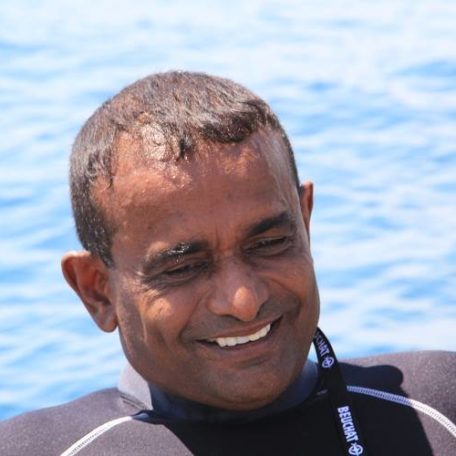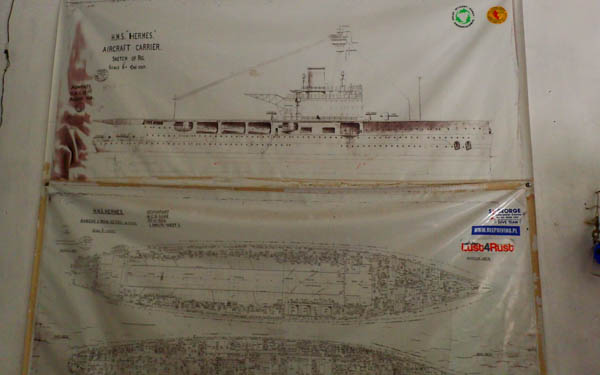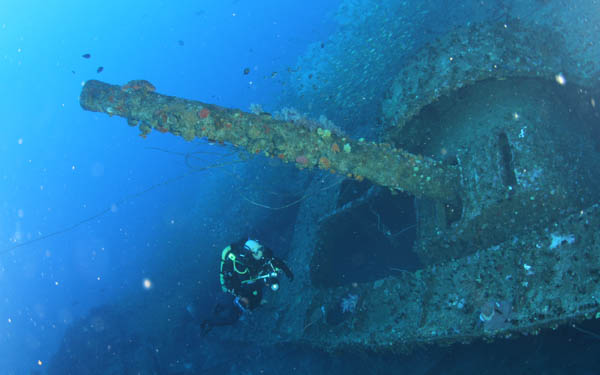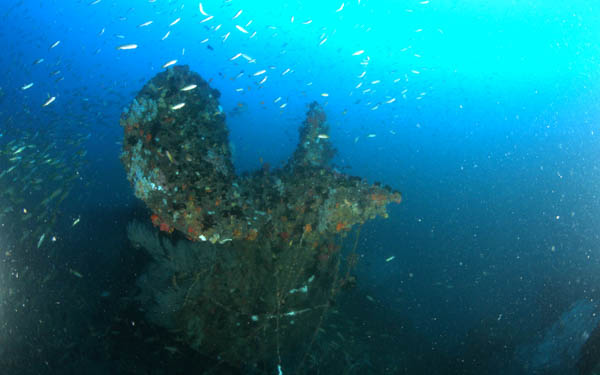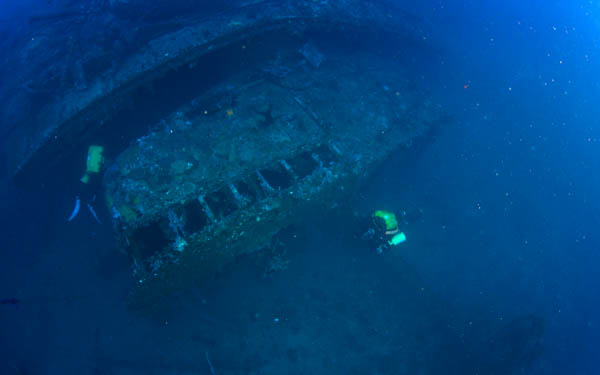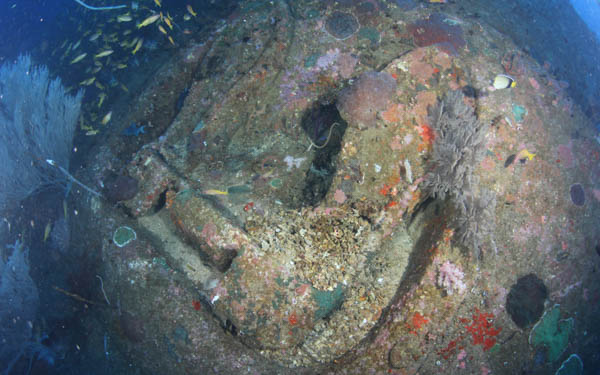The ultimate wreck dive of the world! Absolute adventure TEC and CCR playground! DIVE INTO THE HISTORY
Feli Fernando considers his finding the location of the world’s first purpose-built air craft carrier bombed and sunk by the Japanese Imperial navy during the Indian ocean raid lost for more than 3 decades due to fishing restrictions and the unrest in the east coast of Sri Lanka, as the highlight of his career. According to Feli, diving the Hermes is the ultimate wreck dive. The minimum requirement is TEC 45 as the wreck rests at a depth of 53 m. With Feli’s technical competence, vast experience, intimate knowledge of this spectacular dive site makes the dive memorable. Feli manages Sri Lanka Diving Tour’s the only accredited TEC / REC & CCR dive center in Negombo, Trincoomalee and Batticaloa, After the re discovery of the wreck in 2002 Feli has dived the wreck HMS Hermes more than 950 times.
Over all length of the Wreck is 183 m. Wreck certainly needs about 10 or more dives to fully explore without getting addicted for wreck dive explorations. !!
1) Tour one – Hover around 42 – 45m – within the Black coral garden and the magnitude of of fish !! Get acclimatized to the conditions and refresh skills at the depth. Usual Temp at 40m is around 27 C
2) Hover towards the anchors, view Anchor chains Forwards Heads, Anti air craft armaments %.% inch B L guns boxes of live magazines etc
3) Explore the Super structure, Monkey bridge, Crows nest, depth charges and my favorite Range finder !!
4) Tour of the Propellers !! Magnitude of fish !!
5) Continuation Tour of the Props , view Depth charges, Cannons, and the debris of the flight deck et
BULLET PROOF VIP CAR Wreck
17 – 27 m
Wreck We Ling The FAKE NAME USED BY TERRORISTS- known as A-522 was sunk on the 26th March 2018 to from an artificial reef and a dive site. 8 VIP Bullet Proof Cars (Jaguar, BMW, Mercedes, defender etc used by the Ex-Presidents of Sri Lanka were sunk having the hubs of the cars welded to the hatch.
Letgth 62 m Width 8 m weight 850 tons, Sand bottom depth is 25 m into the cars 26 m top of the wreck is 18. Ideal for enriched air nitrox. An excellent fish breeding ground
Sieh dir diesen Beitrag auf Instagram anEin Beitrag geteilt von SäsHáã FerŋäŋDŏ (@sashaafernando) am
Wreck Chief Dragon
32 m
Boat elapse time 1 hour and 20 min in smooth seas
Taprobane Wreck
36 m
Boat elapse time 1 hour and 20 mins. Ship had transported auto spare parts. Many items like hubs differentials and other stuff can be seen.
Ula Gala (Barracuda Reef)
3 – 12 m
Good for snorkelers and for the open water training dive no 1. Situated at a distance of 5 km from the dive centre. Large groupers, oriental sweet lips, travelly, yellow jack and loads of other fish can be seen. A part of the wreckage of the ship Asia carrier which ran a ground in 1980 can be seen.
Musgraf Ship Wreck
14 m
Just 15 mins from the dive centre, the wreck has been resting since 60 years. She has transported charcoal before she sank. A part of the cargo can still be found in the hatch. Full of marine life. An excellent fish breeding site. Often found fish nets right round the wreck. Need some dives to do a good clean up.
Derana Gala
25 m
The reef is situated 13 km from the dive centre. Need 20 min in smooth seas. A narrow reef patch which is about 10-15 m wide and 150 m in length. Excellent marine life. Schools of barracuda, travelly, fusiliers, blue stripe snappers, honey comb moray, Lion fish can be seen. One of the finest dive sites in Sri Lanka. The best marine life!
Mutian Gala
10 – 12 m
A very good site for the open water training dive no 1. Two oval shape reefs situated on the sandy bottom with a very rich marine life. Loads of lion fish, honey comb moray, blue stripe snappers, fusiliers, many other colourful fish to be observed. More often marble rays nest in a small cave.
Leopard Rock
12 m
A small rock located a few hundred meters from the Mutian Gala. The sandy bottom is a breeding ground for blue spotted sting rays. More often North wards of the rock large Leopard rays with wing span of 2- 3 m can be seen. Dive ten times this reef see Leopard Rays about 4 to 5 times. 50% successful. Before the commencement of the dive get a thorough briefing from your instructor. Main thing if you see them partially buried in sand with a long white tail visible from a distance. Stay calm, sink to the bottom, avoid eye contact, get closer like a floating object!
Maha Gala
14 – 16 m
Good site for various levels of training dives. A very large reef with a lots of exotic fish including, Lobsters, groupers, snappers, lion fish and loads of many other stuff. Large whip type black coral growth is found on top of the reef along with anemones. Need more than one dive to fully explore.
Mora Wala (Shark pit)
1-3 m
An excellent spot for snorkeling! A small coral bed with staghorn coral, blue corals etc. Situated adjoining a small ridge of a reef where small black tips reef sharks can be observed. Everything is dictated by the weather.
Uravi Gala (Grouper Rock)
16 m
Situated just a few km from the Maha Gala. Groupers of various sizes can been seen along with snappers, fussliers, Rays and many other types of fish. Drop anchore and descend along the rope to observe the exotic marine life in and around the reef.
Mutu Paraya (pearl reef)
16 m
A very good site for the open water training dive no 3 or 4. One of the most beautiful reefs full of marine life. Teddy bear coral and over hundreds of different kinds of fish of various sizes to be observed. Time to time anglers can be seen fishing near the reef. Discarded fishing nets as well as fishing hooks are found on the reef.
Air craft wreck
Wreckage of a British twin engine air craft which crashed in the year 1945. The pilots were rescued by a fisherman who was on a Teppama. A kind of a traditional fishing craft made out of wooden logs. Small sails can be used to cover a long distance. A dual purpose dive. Wreck and a reef. Wreck is situated about 10 m away from the reef. A good site to test your navigational skills.
Drop anchor on top of the reef and swim to the top most point of the reef which looks like the cock pit and turn to a heading of 130 degrees on your compass. Reach the edge of the reef and turn to a heading of 060 degrees which will bring you straight to the wreck. This is a good dive site to test the navigational skills. A fish/sea cucumber collector fisherman diver had accidentally come across the air craft wreck and removed the Ribs part of the wings, the battery, the air cleaner of the wreck and sold those items as scrap iron.
Lots of different parts of the air craft is scattered around the fuselage and the two engines. Parts of the wing a petrol tank and many other parts as well as the engines can be identified.
Kammala coral reef
22 m
Large loud speaker look like corals (therbineria) with full of exotic fish can be seen. More often large marble rays, fussliers, snappers travelly and loads of other kinds of fish to be seen. One of the many breeding grounds for cuttle fish. Pairs can be seen.
Kammala coral patch
Just a few kms away from the Kammala coral reef, traditionally known as the 9 fathoms reef. (nava bambe gala). Similar in size of the kammala coral reef.
Diyamba Gala
22 – 26 m
Another very good site for a deep dive. Bottom of the sea bed is 26m. Top of the rock is about 22m. More than four rocks with small caves can be seen. More often Honey comb moray and a giant green or black moray can be seen in one hole together sharing one spot.
Hipolis pits
26 m
Reef looks like pits are full of cleaner shrimps, fussliers, rubber lips, sweet lips and loads of other fish can be seen. A very good site to test your navigational skills.
Diyamba Suda
17 – 30 m
Mistakenly named as the 3rd reef by some divers. The last frontier before the depth of the Indian Ocean is reached. Actually the 10th reef if the reefs are counted on a straight line. About 15 to 20 different rocks and reefs are found enroute to the site.
The reef has a lots of LOBBED PORE corals on which Christmas tree worms can be seen with different colours. Usually excellent visibility. The shallowest is about 17 m and goes down to about 25 – 30 m. Strong currents can be encountered. A few pet fish collectors have gone missing. Need reliable boats more than one.
Maha Kabaru Gala (Giant Travelly Reef) in Katuneriay Wennapuwa
18 m
One of the richest reefs, full of exotic fish, loads of blue stripe snappers, marble rays, fussliers, Travelly, lobsters, cuttle fish and much more to see. Reef is situated 5 mins away from the air craft wreck. Good for macro photography. Plenty of nudies to be seen. Vis – 10 – 15 m.
Eleven Fathoms Reefs
21 m
Off Katunriay – Wennapuwa (45 mins by boat). Loads of blue stripe snappers, lobsters, travelly black corals, Honey comb morays and much more to be seen. Visibility 10 – 15 m. Current moderate. Occasional visitors like black tip reef sharks, spotted eagle rays, Marble rays, and other stuff to be seen.
Wellamankarai diyamba gala
6 – 16 m
Boat time 30 min. Very long reef bed. 20 m in width and a few hundred metres in length. Reef is very rich from marine life and an anglers paradise.
Wade sitham pruwa
16 m
20 min boat drive from Negombo. The only reef on which divers have seen sea horses. Lobsters, snappers, nudies and much more to be seen.
Dakune Gala
18 m
Situated south of maha gala. Loads of lobsters, travelly, rubber lips, and much more to be seen.
Kantiri Gala
14 – 16 m
A reef where you find different varieties of Nudibranchs. 20 min boat drive.
Leena Gala
28 – 34 m
The deep site. Ideal for deep diver training. Plenty of fish. Barracuda, Travelly, fussliers and other s
BULLET PROOF VIP CAR Wreck
17 – 27 m
Wreck We Ling The FAKE NAME USED BY TERRORISTS- known as A-522 was sunk on the 26th March 2018 to from an artificial reef and a dive site. 8 VIP Bullet Proof Cars (Jaguar, BMW, Mercedes, defender etc used by the Ex-Presidents of Sri Lanka were sunk having the hubs of the cars welded to the hatch.
Letgth 62 m Width 8 m weight 850 tons, Sand bottom depth is 25 m into the cars 26 m top of the wreck is 18. Ideal for enriched air nitrox. An excellent fish breeding ground
Sieh dir diesen Beitrag auf Instagram anEin Beitrag geteilt von SäsHáã FerŋäŋDŏ (@sashaafernando) am
Wreck Chief Dragon
32 m
Boat elapse time 1 hour and 20 min in smooth seas
Taprobane Wreck
36 m
Boat elapse time 1 hour and 20 mins. Ship had transported auto spare parts. Many items like hubs differentials and other stuff can be seen.
Ula Gala (Barracuda Reef)
3 – 12 m
Good for snorkelers and for the open water training dive no 1. Situated at a distance of 5 km from the dive centre. Large groupers, oriental sweet lips, travelly, yellow jack and loads of other fish can be seen. A part of the wreckage of the ship Asia carrier which ran a ground in 1980 can be seen.
Musgraf Ship Wreck
14 m
Just 15 mins from the dive centre, the wreck has been resting since 60 years. She has transported charcoal before she sank. A part of the cargo can still be found in the hatch. Full of marine life. An excellent fish breeding site. Often found fish nets right round the wreck. Need some dives to do a good clean up.
Derana Gala
25 m
The reef is situated 13 km from the dive centre. Need 20 min in smooth seas. A narrow reef patch which is about 10-15 m wide and 150 m in length. Excellent marine life. Schools of barracuda, travelly, fusiliers, blue stripe snappers, honey comb moray, Lion fish can be seen. One of the finest dive sites in Sri Lanka. The best marine life!
Mutian Gala
10 – 12 m
A very good site for the open water training dive no 1. Two oval shape reefs situated on the sandy bottom with a very rich marine life. Loads of lion fish, honey comb moray, blue stripe snappers, fusiliers, many other colourful fish to be observed. More often marble rays nest in a small cave.
Leopard Rock
12 m
A small rock located a few hundred meters from the Mutian Gala. The sandy bottom is a breeding ground for blue spotted sting rays. More often North wards of the rock large Leopard rays with wing span of 2- 3 m can be seen. Dive ten times this reef see Leopard Rays about 4 to 5 times. 50% successful. Before the commencement of the dive get a thorough briefing from your instructor. Main thing if you see them partially buried in sand with a long white tail visible from a distance. Stay calm, sink to the bottom, avoid eye contact, get closer like a floating object!
Maha Gala
14 – 16 m
Good site for various levels of training dives. A very large reef with a lots of exotic fish including, Lobsters, groupers, snappers, lion fish and loads of many other stuff. Large whip type black coral growth is found on top of the reef along with anemones. Need more than one dive to fully explore.
Mora Wala (Shark pit)
1-3 m
An excellent spot for snorkeling! A small coral bed with staghorn coral, blue corals etc. Situated adjoining a small ridge of a reef where small black tips reef sharks can be observed. Everything is dictated by the weather.
Uravi Gala (Grouper Rock)
16 m
Situated just a few km from the Maha Gala. Groupers of various sizes can been seen along with snappers, fussliers, Rays and many other types of fish. Drop anchore and descend along the rope to observe the exotic marine life in and around the reef.
Mutu Paraya (pearl reef)
16 m
A very good site for the open water training dive no 3 or 4. One of the most beautiful reefs full of marine life. Teddy bear coral and over hundreds of different kinds of fish of various sizes to be observed. Time to time anglers can be seen fishing near the reef. Discarded fishing nets as well as fishing hooks are found on the reef.
Air craft wreck
Wreckage of a British twin engine air craft which crashed in the year 1945. The pilots were rescued by a fisherman who was on a Teppama. A kind of a traditional fishing craft made out of wooden logs. Small sails can be used to cover a long distance. A dual purpose dive. Wreck and a reef. Wreck is situated about 10 m away from the reef. A good site to test your navigational skills.
Drop anchor on top of the reef and swim to the top most point of the reef which looks like the cock pit and turn to a heading of 130 degrees on your compass. Reach the edge of the reef and turn to a heading of 060 degrees which will bring you straight to the wreck. This is a good dive site to test the navigational skills. A fish/sea cucumber collector fisherman diver had accidentally come across the air craft wreck and removed the Ribs part of the wings, the battery, the air cleaner of the wreck and sold those items as scrap iron.
Lots of different parts of the air craft is scattered around the fuselage and the two engines. Parts of the wing a petrol tank and many other parts as well as the engines can be identified.
Kammala coral reef
22 m
Large loud speaker look like corals (therbineria) with full of exotic fish can be seen. More often large marble rays, fussliers, snappers travelly and loads of other kinds of fish to be seen. One of the many breeding grounds for cuttle fish. Pairs can be seen.
Kammala coral patch
Just a few kms away from the Kammala coral reef, traditionally known as the 9 fathoms reef. (nava bambe gala). Similar in size of the kammala coral reef.
Diyamba Gala
22 – 26 m
Another very good site for a deep dive. Bottom of the sea bed is 26m. Top of the rock is about 22m. More than four rocks with small caves can be seen. More often Honey comb moray and a giant green or black moray can be seen in one hole together sharing one spot.
Hipolis pits
26 m
Reef looks like pits are full of cleaner shrimps, fussliers, rubber lips, sweet lips and loads of other fish can be seen. A very good site to test your navigational skills.
Diyamba Suda
17 – 30 m
Mistakenly named as the 3rd reef by some divers. The last frontier before the depth of the Indian Ocean is reached. Actually the 10th reef if the reefs are counted on a straight line. About 15 to 20 different rocks and reefs are found enroute to the site.
The reef has a lots of LOBBED PORE corals on which Christmas tree worms can be seen with different colours. Usually excellent visibility. The shallowest is about 17 m and goes down to about 25 – 30 m. Strong currents can be encountered. A few pet fish collectors have gone missing. Need reliable boats more than one.
Maha Kabaru Gala (Giant Travelly Reef) in Katuneriay Wennapuwa
18 m
One of the richest reefs, full of exotic fish, loads of blue stripe snappers, marble rays, fussliers, Travelly, lobsters, cuttle fish and much more to see. Reef is situated 5 mins away from the air craft wreck. Good for macro photography. Plenty of nudies to be seen. Vis – 10 – 15 m.
Eleven Fathoms Reefs
21 m
Off Katunriay – Wennapuwa (45 mins by boat). Loads of blue stripe snappers, lobsters, travelly black corals, Honey comb morays and much more to be seen. Visibility 10 – 15 m. Current moderate. Occasional visitors like black tip reef sharks, spotted eagle rays, Marble rays, and other stuff to be seen.
Wellamankarai diyamba gala
6 – 16 m
Boat time 30 min. Very long reef bed. 20 m in width and a few hundred metres in length. Reef is very rich from marine life and an anglers paradise.
Wade sitham pruwa
16 m
20 min boat drive from Negombo. The only reef on which divers have seen sea horses. Lobsters, snappers, nudies and much more to be seen.
Dakune Gala
18 m
Situated south of maha gala. Loads of lobsters, travelly, rubber lips, and much more to be seen.
Kantiri Gala
14 – 16 m
A reef where you find different varieties of Nudibranchs. 20 min boat drive.
Leena Gala
28 – 34 m
The deep site. Ideal for deep diver training. Plenty of fish. Barracuda, Travelly, fussliers and other s
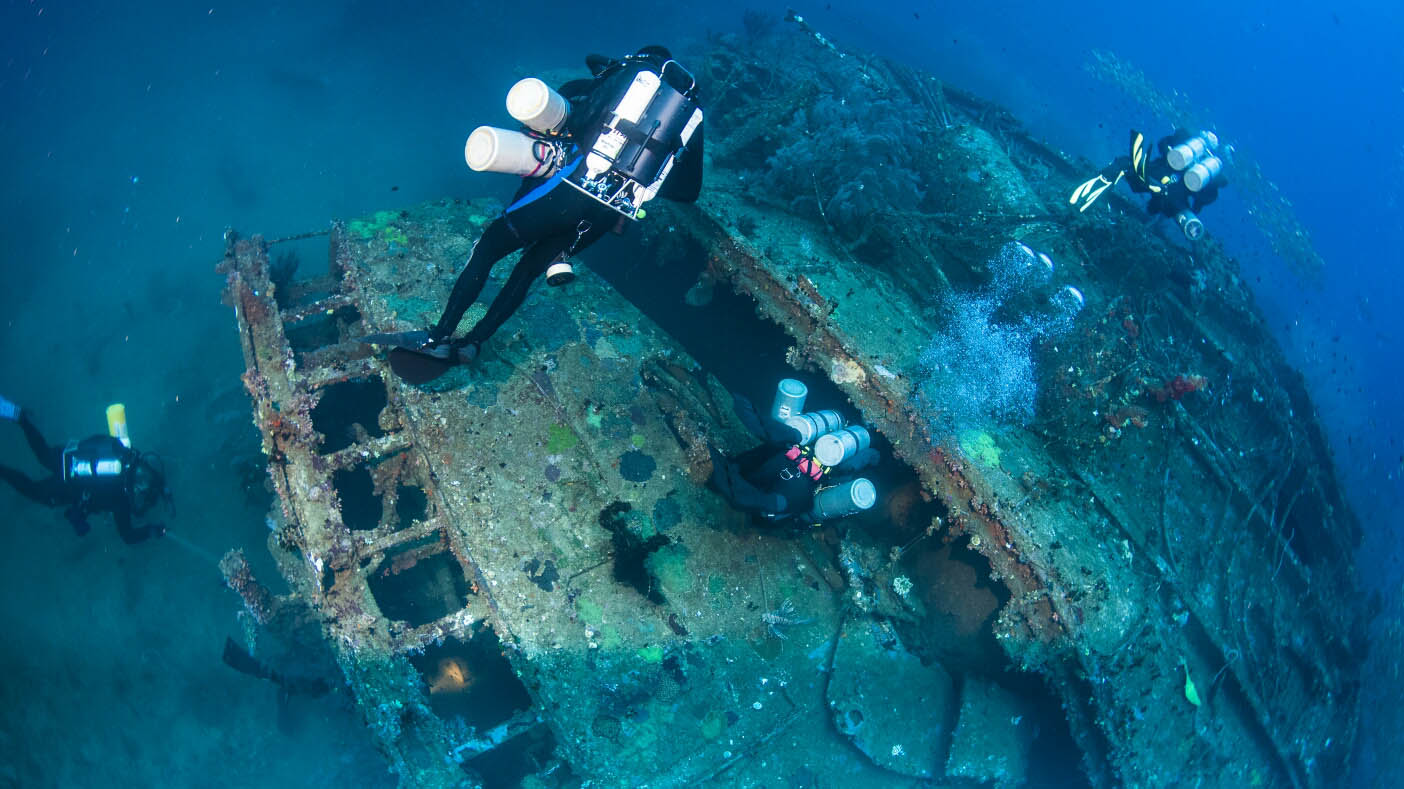
How Feli rediscovered the lost wreckage HMS Hermes
The aircraft carrier HMS Hermes set sail from Trincomalee harbour on 09/04/1942 on a mission. A Japanese invasion was impending. About 70 carrier borne Japanese bombers had taken off from 3 Japanese carriers which had entered Bay of Bengal the week before attacked the Trincomalee harbour end other allied naval assets. The Japanese air fleet managed to sink this carrier and other destroyers during the attack. They attacked the Trincomalee harbour and the oil tank as well. The carrier is supposed to have got about 40 direct hits and sank within 10 minutes. From the complement of HMS Hermes 19 officers including the captain (R. J. Onslaw) of the ship and 278 ratings lost their lives. About 400 were rescued by a Hospital ship, Two or three days later three heavily decomposed bodies were found on the beach near the Batticaloa light house. Two of the bodies had the name tags and one was without a name tag. The photographer who managed to save his life visited the site along with his son on board a Sri Lankan naval vessel. The vessel midshipmen Capt. Edward Jayawardana had entered these details in his journal. Subsequently the son of the photographer wrote in a journal of the ill-fated carrier taking the notes his father made. He also revisited Sri Lanka along with his father’s ashes to dump it over the shipwreck to fulfill his father’s last wish. Incidentally Capt. Edward Jayawardana was again tasked to carry out this mission. These incidents are appended in the next edition of the journal of HMS Hermes.
I clarified the details obtained from the Internet regarding the positions from Capt. Edward Jayawardana. I was determined to visit this wreckage and made elaborate plans since this wreckage has a historic value. The mission was quite dangerous and life threatening as the wreckage was supposed to be lying at a depth of 60 meters according to the information. The PADI recreational dive planner limits its dives only up to 42 meters. The non-decompression limit is 9 minutes at this depth and any stay beyond that requires decompression stop starting at 9 – 12 meters. Depending on the length of stay.
The divers air consumption at this depth is normally very high due to high surrounding pressure which is about six times more than the surface. In my more than 2400 log dives, I had passed 40 meters about 45 times. Hence I was confident enough that I would not encounter any problems such as Nitrogen Narcosis, since during these dives I managed without any difficulties. Nitrogen Narcosis is the diver getting a feeling of intoxication, false safety, security and non responsiveness for buddy’s signals etc. due to the excess quantity of nitrogen in the blood stream.
On 14/04/02 my buddy and myself arrived at Batticaloa planning to dive next day. We managed to find a boat to transport us to the site. The boatmen were not familiar with the site since they haven’t fished in that area for many years. After a 45 minutes journey using the global positioning system we arrived at the approximate site. The echo sounder/ fish finder sounded a depth of 48 meters. I got the boatmen to shift the boat forward and backward and recorded the depth on both sides which was around 60 meters and laterally 48 meters. The position matched the details of Capt. Edward Jayawardana. We got the boatman to anchor, after determining that the boat was steady on anchor, we dropped the two additional tanks fitted with an extra primary and secondary air sources to a depth of 15 meters. Thereafter we got into our diving equipment carried out thorough functional checks and rolled over the boat to the deep sea. We directly swam to the anchor rope and started our descent.
Although the current was very strong we managed to descend along the anchor rope. My buddy was also an experienced PADI scuba diving instructor. We stopped at 15 meters to check the additional tanks and secured it to the anchor rope. After satisfying ourselves about the safety of the additional tanks we started descending from these additional tanks knowing the fact that they were our life saving equipment. After spending 20 minutes at a depth of 48 meters since we cannot arrive on the surface directly, as the excess nitrogen in our tissues would bring us to decompression sickness, which can be fatal. Upon descending up to 30 meters we could see the astonishing site of HMS Hermes which was my dream to explore lying in a majestic way. The environment had not caused any damages . The ship was very well intact. It had tilted portside to the ground.
There were large and tall gorgnia corals, giant seaferns all over the wreckage. These corals had grown uninterrupted over the past 60 years. There were large fish moving freely not caring about the two intruding divers. We saw fish like red snappers, larges Travelly (paraw) seer and Barrac We secured a rope to the anchor line and started moving along the wreckage of the ship. We observed an anti aircraft gun at the mid section. The corals were very fascinating. During my 2400 logged dives at places like Maldives, Malaysia, Singapore, Indonesia and in local areas such as Negombo, down south , Trinco and in other places I had never sighted such beautifully grown Georgina corals. The fish like large Trivelly were not concerned about the divers presence. We were hovering at a depth of 48 meters without descending to the seabed.
The wreckage, which was in good shape, needs many more dives to explore fully. We managed only to explore 50m out of 195 meters. The ship had sunk tilting port side down. The depth to the starboard side was 48 meters and sand bottom/seabed is at a depth of 55 meters. After spending 20 minutes on the wreckage we started to ascend along the anchor rope. We stopped at the additional tanks and carried out decompression stops as required by our dive computers. The additional tanks were very handy since we had only about 70 bar left in our tanks when we reached the additional tanks.
It is pertinent to mention the 20-min spent at the wreckage was the most exciting and adventurous dive in my entire diving career. A dive to this wreck would be very interesting and an adventure for any experienced and nature loving diver. The surface current in this area is generally very strong, the water clear. Divers will have to be well prepared and physically fit and need to be well aware of technical diving.
In the whole world there are only two wreckage of aircraft carriers for recreational divers to see. This is certainly one of them and the other is supposed to be the USS Saratoga.
All other wreckages of aircraft carriers rest in unreachable depths for recreational divers. Upon developing the film role we understood that we should use very powerful strobes to get clear images.
The details of the ship is as follows. LOA 195 m Boa 22 m weight 10950 tons. Weapons 5.5 cannons. 4 anti aircraft guns and 12 aircrafts.
For more than three decades a dive to this historic wreckage was impossible due to the security situation. Now it has changed. An adventure technical dive to this historic wreckage has become major tourist attraction. Now the exact waypoint is marked in my instruments and this will enable me to reach the site with pinpoint accuracy.
The Australain destroyer “Vampire” which lost nine men is yet to be found. The aircraft carriers used by the Japanese force for these battles are supposed to have used by them to attack the Pearl Harbour as well.
